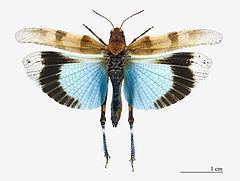Kingdom Animalia Superfamily Acridoidea Phylum Arthropoda Rank Subfamily | Suborder Caelifera Scientific name Oedipodinae Higher classification Acrididae Order Orthoptera | |
 | ||
Lower classifications Migratory locust, Zayante band‑winged grasshopper, Pallid‑winged grasshopper, Oedipoda caerulescens, Oedaleus infernalis | ||
Bandwings, or band-winged grasshoppers (subfamily Oedipodinae) is a group of insects classified under the family Acrididae. They are sometimes elevated to full family status as Oedipodidae. They inhabit primarily xeric weedy fields.
Contents
These species are colorful, usually with hindwings that are yellow or red and edged with black. Others have black hindwings with pale edges, and a few species (including the most economically important ones) have clear hindwings. The arolium is extremely small or absent.
Defense
When bandwings feel safe, they appear drab. When they feel threatened, they leap out to reveal bold and bright colors. Some predators might even mistake the Blue-winged grasshopper for butterfly. But when the predator looks for the grasshopper, it is hiding in the grass. Bandwings continue this process if the predator tries to attack them.
Tribes and selected genera
Numerous genera are not yet assigned to tribes. These include:
Angaracrisoides – Asphingoderus – Atympanum – Aulocaroides – Aurilobulus – Austroicetes – Brancsikellus – Chloebora – Chondronotulus – Chortoicetes – Crinita – Cyanicaudata – Diraneura – Dittopternis – Elmisia – Eokingdonella – Eremoscopus – Eurysternacris – Fitzgeraldia – Flatovertex – Homoeopternis – Humbe – Jacobsiella – Jinabia – Kinshaties – Leptopternis – Longipternis – Mecistopteryx – Mioedipoda – Morphacris – Nepalacris – †Nymphacrida – †Oedemastopoda – Oreacris – Promesosternus – Pseudaiolopus – Pycnocrania – Pycnodella – Pycnodictya – Pycnostictus – Qualetta – Rashidia – Tibetacris – Tmetonota – Wernerella – Yiacris – Zimbabwea
The genus Cibolacris was originally placed in Oedipodinae, and later moved to Gomphocerinae. The genus Stethophyma is traditionally included in Oedipodinae, but North American authors in particular sometimes place it in the Gomphocerinae or Acridinae. Some authors place all members of Oedipodinae within the subfamily Acridinae, and there has been much confusion and debate about the limits and relationships of the two subfamilies.
